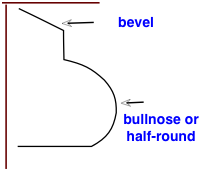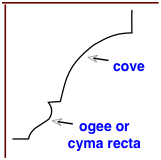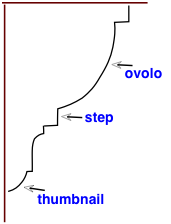Trim Molding Profile Examples
by: Dale Cox
This page contains pictures for many wood trim moldings that can be stacked in combination to create new designs, or to match an existing profile. Some of these profiles are available from your local home stores, others can be found at a lumberyard or they can be custom milled at a millwork. Usually all that's needed is a photo of the design for a shop to make the pieces you want.

Rake Mould
This profile is sometimes called solid crown, it may be used to trim around the top of a wall in a room with a low ceiling or used in many combination designs. Sizes range from under 1 to over 3 inches, used for a variety of applications including a transition from a molding profile to a wall or ceiling.

Base Cap
Base cap is used to finish the top of a baseboard but can also be used to finish combo-molding edges or to transition from one level of a profile to another.

Panel Mould
These are normally used to build decorative wainscot and wall frames in large rooms with high ceilings. These are also a nice touch along the center of a chair rail.

Backer Board
These boards are used as an anchor for building a combination design. Use a piece with two finish edges for chair rails or a cornice. The other examples are one-piece moldings used for baseboards and door casing but they also work well for crown designs.

Reeds and Flutes
Reed moldings are frequently used to build elaborate chair rails and door casings. The fluted profile is a staple when building Neoclassical style door and window casings. Also, try stacking a reed profile with one of the backer boards above, for a quick custom chair rail.

Brick Mould
These are normally used to trim around door and window frames on the exterior of a building. They can also be used to enhance the effect of wide crown moldings and cornices, adding dimension to the profile.

Back Band
These pieces are commonly used to trim the square edge of a surfaced board or a simple baseboard to create a wide trim similar to those used in Victorian architecture. This works well to create wide crown profiles as well.

Stop Bead
Stop bead is used to stop a swinging door or to keep a window sash aligned. These can also be used in combination with other small molding pieces to simulate larger, elaborate profiles or as a transition between horizontal and vertical pieces of a profile as in this wainscot cap.

Dentil Molding
These can be installed under standard crown profiles to create traditional dentil crown moldings. Also, try stacking these under a back band, cove, base cap or other small pieces to decorate door and window casings or chair rails.

Standard Baseboard Profiles
These one-piece baseboard profiles are used in many new homes and are easy to find at home stores and lumberyards. They can also be used as backer boards for crown molding and chair rails.
Sizes are available from about 2½ to about 8 inches wide so a suitable piece can be found for just about any application.

Custom Milled Baseboards
Baseboard profiles like these and the larger ones below are usually not found at local home stores. A lumberyard may have designs like this or they can be custom milled by companies set up to cut custom profiles, usually all that is needed is to supply them with a drawing of the design you want.

Larger Custom Baseboards
Finish the bottom of these larger baseboards with an elaborate shoe mold or stack them with smaller moldings to build more elaborate baseboards.
Cove Crown Profiles

This crown profile consists of a large cove in the main body and a large bead along the bottom. This molding can be found at a lumberyard or millwork but may not be available from home stores.

This profile consists of a reverse ogee and cove along the bottom. Another molding profile that will be hard to find at home stores.

This is a more common one-piece crown known as bed mould. This profile will usually be found at home stores as well as lumberyards.
Beaded Crown

This molding consists of a large cove in the main body and a bead running along both top and bottom edges. This profile may be found at home stores but will almost certainly be at a lumberyard or millwork.

This crown profile is more rare and will probably only be found at a millwork, if at all. It can be copied from this image by a millwork set up to make custom molding or this profile can be recreated by stacking small pieces like those in the custom crown molding project.

This one-piece crown profile consists of several prominent features including: a step and ovolo or quarter round at the top, a fillet and cove along the middle, and an ogee and small cove along the bottom. Here again, this molding would only be found at a millwork or can be custom cut.
Embossed Crown

This embossed crown molding is cut with an egg and dart pattern along the middle under a reverse ogee. The bottom is finished with a second, smaller reverse ogee. This profile may be found at a home store but will certainly be available from a lumberyard.

This embossed crown incorporates a dentil pattern and two reverse ogees cut all in one-piece. Home stores will usually carry a design like this although it may only be available in a manufactured molding like polyurethane. This profile can also be built using a standard crown profile and adding the dentil and rake mould along the bottom.

Basic Casings
These casing profiles are available from most home stores. These are common profiles for average rooms with 8ft ceilings. Sizes from 2¼ to about 3½ are available, though some of the sizes pictured here may require a special order.

Victorian Casings
These are usually not found in a typical home store but a lumberyard will have one or two profiles like this. These wider, thicker moldings are usually found in older homes with large rooms and high ceilings.

Neoclassical Casings
Some of these can only be found at a millwork or lumberyard. These Neoclassical style casings are used in elaborate molding designs typical of a grander home in the Georgian or Federal style.

Historic Casings
These casing are typical of historic homes. Some of these can only be found at a millwork lumber company where these profiles are cut on site. A millworks can also reproduce a profile from a picture or sample. If you're doing renovations and remodeling of older and historic properties, you can replace rotted and damaged wood trim with a perfect match.

Small Base Cap
These are very common base cap profiles and can be found at your local home store. Other uses for this basic trim include stop bead on doors and windows or they can be modified to create back band and wainscot cap. Also, try installing one of these upside down for an interesting shoe mould.

Medium Base Cap
These base cap profiles are a little harder to find at home stores but a lumberyard will have several like this.
These slightly larger base caps also make good components for building custom profiles for crown and door and window cases. Like the other moldings on this page, these can be modified by cutting a rabbet along the back or by adding a square strip to create back band and other trim.

Large Base Cap
These more elaborate base cap profiles will usually only be found at a lumberyard or millwork. A millwork set up to cut custom profiles can also reproduce these from a printout of these images.
These larger pieces can also be used as a one-piece chair rail or for building custom crown, door and window cases, and chair rails.

Chair Rail
These are common one-piece chair rails that can be used alone or combined with other trim pieces to build a more elaborate design. These are milled with several interesting features including beads and ogee profiles. Some of the wider, thicker pieces here are best used in combination with wide door and window casings found in Victorian styles. The thicker pieces mate well when butting the chair rail against the side of the casing.




 Building Stacked Trim Molding
Building Stacked Trim Molding